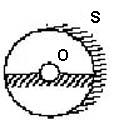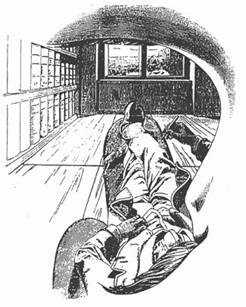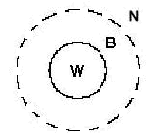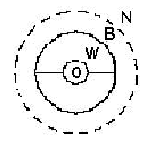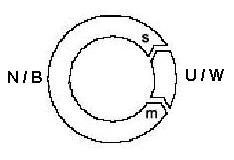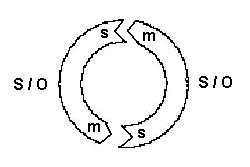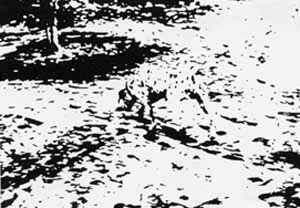Schult, Joachim (Hg.) (2004): Biosemiotik – praktische Anwendung und Konsequenzen für die Einzelwissenschaften. Studien zur Theorie der Biologie 6. Verlag Bildung und Wissenschaft, Berlin, 155 – 165
About lines, pictures, things, animals and man Anton Fuerlinger, Vienna (shortened and slightly altered, original see pdf ) Thomas Sebeok says that "the domain of semiotics is in fact essentially conterminous with what is today practised under the label of cognitive science". Accordingly, I take the nervous system (NS) as the organ of interpretation in animals and man. Only vertebrates are considered here, their evolution has started roughly with paleozoic fish and has proceeded to our own species so far. A neuroscientific approach to semiotics is not yet worked out, worse, there is still no global theory of the brain – so let me show here that a single brain cannot be explained on its own. We start by analysing how philosophers show our epistemic faculty: Sitting and watching an object like a glass of water or a table in front of him or her. My body – interface between world and mind If the subject S looks at the object O in his visual field: He/she (henceforth he) sees the horizon of the earth in the background and in the foreground the object O like a ball: "Outside", better "around" the view of the observer is S, now referring to his body. Vision is framed, the body is always surrounding the view like a hole or a tube. An observing subject looks out, he is endo-positioned - and so are we if we succeed in taking his viewpoint. For a better illustration here is the "view of the left eye" first shown by E. Mach (1922): You can see the situation of a person looking at himself stretched out on a long chair inside a room: Such a view if perceived as a whole is a (re)construction of many "partial representations per glimpse", assembled by saccadic eye movements. The truly subjective left-eyed-view (close your right eye!) is framed on the right side by the nose of the person and upwards by the eyebrow. It is not so clearly framed to the left and downwards. Nothing is visible outside the vision field, but in everyday situations we don't care because we know what's around - at least we think so. This knowledge or conviction of "continuity around us" serves as a (mental) extension of the visible world proper, the mental domain extends (outwards of) the actual moment's view. The further situation is accessible "on demand", by turning the eye, the head or the body. Contrary to our belief and everyday experience our actual vision field is bounded, the body forms a window-like frame around it. Imagine that in forward locomotion the frame is carried along and the time axis will make it a tube or a channel. Behavioural experience (here: vision during locomotion) is a "body-channeled" process. The subjective view turns the relation of the body and it's visual world inside out. The visual world W appears in the centre of attention of the subject, then comes the framing body B and encompassing both is the working space of the NS, the mental domain. The body B separates and connects W, the visible world and N, the mental extension of the visible world. That we sometimes realize being trapped in our body is an example of the more general idea of "endophysics" first introduced by O. Roessler (1987). The world/body contrast line (which distinguishes the observer and the observed) is only in parts visible as a contour line, and it is blurred. (In Mach's picture it is drawn as a sharp line). You won't find a border between your body and your mind, there is no line of distinction. Because vision clearly makes sense of the environment, less of the body and none of the mind, the focus of interest and attention is in the centre area/layer of our world (view). Within the W we shall expect anything. When an object is attended to, the subjective situation, that is the (view from the) endo-stance, is completed. Object, world, body and mind neatly line up and the 4 domains of experience (reality?) can be drawn in their relation to each other: Finally, as a reader now looking at the sketch above you have still another, an over-all, a real layer of experience: your actual reading situation. Close your right eye (to find your nose as a framing element) and look at the "sign carrier" which is your object. Now we try to "zoom" through the three situations surrounding each other. They are transparently framed for our visual experience, though boxed like a Russian doll. The first is the last mentioned: the book/paper/screen is the object 1 and the background is the actual situation around you. The second is difficult because the sketch as a whole is the object 2 and the (more or less) white area around is the background of the sketch. The third is diagrammatical, schematic only: You must "enter" the sketch and identify with the (nervous system N of the) observer B to look out through his eye(s) into W, the background where the drawn object O is object Nr. 3. The following insert is a short "line phenomenology". Things, organisms etc. have a certain inner space and appear covered by a surface. A sur-face in our biosphere is always an inter-face because natural media like air or water fill in the outer space/distance, so they can also be regarded as "bodies". As a matter of fact (!) a surface or interface is no thing in itself, it is a place where two things touch or border on each other. When we can say that an interface appears between two things or spaces, we can go on saying that a line appears where three things or spaces meet:
The semiotic power of the drawn line lies in its two parallel contours which are simply called a line. It is the most important and widespread sign carrier, only produced by humans and for the purposes of communication. Now we shall pose another, equally "deep" question: How do we classify things or objects? What sort of categorization mechanism do we use, in everyday life, in science, in general? Natural kinds: the "other" theory There is only one way to do the latter, by going back all the way to the very first things/objects, to get hold of their basic, natural categories. But first we ask individually: What was the first object for you or what was the most important one? It's easy to answer these two questions because the answer is normally the same, Mama. Now let us imagine our ancestors in prehistoric times. What objects did they encounter or watch at least? Evolutionary psychologists say that most of our brain functions were shaped during the era of hunter-gatherers, but hunting, competing and other tasks for survival must have developed much earlier. After crossing the border between humans and animals backwards, the first station are "ordinary" primates. They seldom use tools in natural environment but fruit, water, plants and other animals are their most relevant environmental parts. Before that, early mammals were hunters, shrew-sized insectivores. Still, predator avoidance got absolute priority (dinosaurs ruled, and their stepping legs alone were a threat). No artefacts there, insectivores pay no attention to immobile things as we do, the most important objects for them were (and still are) other animals. The last time jump, right into paleozoic waters: no child rearing behaviour, no drinking and for pelagic fish no sheltering. Every thing that is left is "others", living, moving, behaving... in short: The first object in evolution was an other (animal). Consequences of the "other" theory If being hunted, hunting, competition and mating were, and still are, the basic tasks for nervous systems, nothing life relevant in the cognitive -, behavioural - and neurosciences will make sense except in the light of interactive behaviour: 1. J.v. Uexkuell's functional circle is a non-interactional model, a single-individual approach for dealing with the world. How would an interactional extension change it? In the original model below, the sensor (s) and motor part (m) of a nervous system (N, or body B) "grab" a part of the Umwelt (U = world W): Only one of Uexkuell’s four functional circles dealt with the inanimate environment, namely locomotion with obstacles etc., so I propose to represent the three other functions (enemies, prey and sexuality) in a more symmetrical way: The resulting circuit can serve as a general model for interactional systems exemplified in parasitism, hunt, fight, courtship, dance and direct communication. Co-evolution between species most often resulted in mutually adapted, in fact balanced, interactions. During an interaction (at least) two individuals are sender and receiver at the same time, their sensorimotor systems are online (cross-) coupled: motion detection leads to a (re-) action which is detected by the other, leading to a re-re-action etc. Motion triggers motion. To a large extent this is done in a reflex-like manner by the so called mirror neurons (Rizzolatti et al. 1996). The evolutionary origin of these "inner" sensorimotor shortcuts is unknown but hunting is a likely candidate because following each other is essentially "mimetic" (Fuerlinger 1997). 2. The famous "homunculus of cognition" - it is the (behaviour of the) other. Others are the top centre of attention and guidance of behaviour. And to reach a "Global brain theory", centuries long desired, two questions can only be answered with evolutionary theory: (1) Why is our interest and attention so often focused on a single object of desire or avoidance? It is the outcome of attention processes which during the long run of evolution in innumerable encounters most often - and ultimately always! - had to deal with single exemplars/individuals only: a predator, a partner, a prey animal or a competing other. Natural intelligence has solved from its very beginning a lot of "three bodies in interaction" problems; see the first sketch where two mobile bodies interact on top of a (bio-) sphere. In contrast, for an artificial intelligence device an ordinary room with furniture is already a big challenge ("situated cognition", Clancey 1997). In sheer computing power we can compare the catching of a fleeing prey animal or a successful mating event to the soft landing on the moon's surface, our species' collective "highest" achievement. (2) Why is our everyday (and our scientific notion of an) object "de-animated", without movement, agency or reactivity, a glass of water, a table? It is, on the one hand, the vanishing of the two main incentives to move (prey and predators), on the other hand the human urge to describe and thus conserve and immobilise (the remainder of) his main life events. Drawings and pictures emerged that latter way. They are a poor class of stimuli for a battle-tested, at least moving/moved nervous system. To be sure, a paper dog cannot represent a real dog – it can’t bite. Figure-ground, part-whole, Gestalt and "binding" are largely problems of method often resulting from testing procedures where written text or pictures are used. The Dalmatian above commonly used in psychology textbooks would immediately "pop out" if it moved only a millimetre. A salient (latin: jumping) feature needs no pre-cueing, a moving individual appears as both object and event (see epilogue). Biological motion is holistic, it may involve all body parts. For an observer it is more than a feature like form, size or colour, it is an "emotioning" master-feature triggering responses like fear, aggression or freezing together with their motor reactions like fleeing, fighting or hiding. Finally, some more general remarks about our animal heritage. The most challenging, not the most time demanding tasks have shaped the sensor and motor parts of our NS. The three high-priority tasks of interactive behaviour (predator, prey and partner) still dominate our interests, attention, emotions, propensities. Darwin recognized only sexuality as a direct selective force, and ever since him predators and prey are only parts of natural selection like climate and other non-animate environmental changes. As everybody can imagine both hunting tasks demand full activation and acceleration of the whole body in a minimum amount of time, with maximum precision and robustness. Thus the conclusion: early sensor-motor processing (milliseconds in situations of hunting and being hunted!) is a central mechanism of natural selection. We can be sure that vertebrates excelled in both roles for long spans of time during evolution. Recent vertebrates are the product of "neuro-dynamical arm’s races" going on in both contexts for half a billion of years. We humans still command such a hybrid prey- and hunter body. It is run by nervous structures with a general intelligence for seamlessly solving all problems of successive or parallel interaction. Most of the time we are pursuing goals, but always we are trying to avoid threats from others. We may still be "wild at heart", but because we were so often on the menu, we are not so perfect hunters and killers. Konrad Lorenz, ethologist, once said: "There is no intuition ('Anschauung') of space and no intuition of time, there is only one intuition, of movement in space and time". What movement really is we experience "a priori" in mother’s womb from conception on, and after birth every time our whole body is moved actively or passively. "Each self-modifying system creates its own space and time" (after Kampis1994). Humans try to circumscribe "The primacy of movement" (M. Sheets-Johnstone, 1999) with four dimensions, three for space and one for time. By this embedding, descriptions became possible, but "movement as such" is unfathomable for physicists, philosophers, cognitive- and neuroscientists. Animals may live (in or through) a sensorimotor continuum, a permanent "flow" experience, they may not need (a conceptualisation of) space and time. Literature Clancey, W. (1997): Situated Cognition: On Human Knowledge and Computer Representations. Cambridge University Press Fuerlinger, A. (1997): Hunting or following each other: Origins of mimetic skills? in Schmitt, A., Atzwanger, K., Grammer, K., Schäfer, K. (eds): New Aspects of Human Ethology. Plenum Press, New York Kampis, G.: 1994, ‘Biological evolution as a process viewed internally’, in: Atmanspacher, H. (ed.), Inside versus outside, Springer, Berlin & Heidelberg, pp. 85-110. Mach, E. (1987): Die Analyse der Empfindungen und das Verhältnis des Physischen zum Psychischen. Nachdr. der 9. Auflage, Wiss. Buchges. Darmstadt, Jena 1922 Rizzolatti, G., Fadiga, L., Gallese, V., & Fogassi, L. (1996): Premotor cortex and the recognition of motor actions. Cog Brain Res. 3, 131-141 Roessler, O. (1987): Endophysics. in Casti, J., Karlquist, A., (eds): Real Brains, Artificial minds. New York: North Holland Sebeok, T. (2001) Signs.: An Introduction to Semiotics. Toronto Studies in Semiotics and Communication. Sheets-Johnstone, M., (1999): The primacy of movement. John Benjamins Publ. Comp. Uexkuell, J. v. (1928): Theoretische Biologie. Berlin: J. Springer
|


